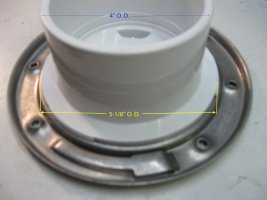Hello All!
I had to move the closet waste in a bathroom. When I put the new riser and long sweep ell, I made an error and the riser is 1/4" out-of-plumb, tilting left as one faces the user side of where the toilet will be. From the top of the long sweep ell to the flange is just under 6 inches, so there isnt enough height to put 22-1/2 offsets.
It's schedule 40 PVC pipe. Dry-fitting the closet flange shows the top to be about 1/4" from level because the pipe is at an angle.
Taking the tee off the stack and starting over will be terrible, as it goes into a multi-inlet fitting with other drains and vents.
The first question is will the wax ring be able to compensate for the out-of-plumb?
The horizontal distance to the stack is about 10", so getting a coupling in to turn the riser pipe plumb might be impossible. I can put a Fernco, but don't know if that is allowed.
Do you all know if either relying on the wax ring or using a Fernco will be an acceptable solution to my error?
Is there a better way to fix my mistake?
Thank You for helping,
Paul
PS: A sketch is attached. I apologize, but my camera is not working today, so no photos of my mistake could be taken.
I had to move the closet waste in a bathroom. When I put the new riser and long sweep ell, I made an error and the riser is 1/4" out-of-plumb, tilting left as one faces the user side of where the toilet will be. From the top of the long sweep ell to the flange is just under 6 inches, so there isnt enough height to put 22-1/2 offsets.
It's schedule 40 PVC pipe. Dry-fitting the closet flange shows the top to be about 1/4" from level because the pipe is at an angle.
Taking the tee off the stack and starting over will be terrible, as it goes into a multi-inlet fitting with other drains and vents.
The first question is will the wax ring be able to compensate for the out-of-plumb?
The horizontal distance to the stack is about 10", so getting a coupling in to turn the riser pipe plumb might be impossible. I can put a Fernco, but don't know if that is allowed.
Do you all know if either relying on the wax ring or using a Fernco will be an acceptable solution to my error?
Is there a better way to fix my mistake?
Thank You for helping,
Paul
PS: A sketch is attached. I apologize, but my camera is not working today, so no photos of my mistake could be taken.

